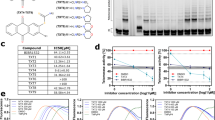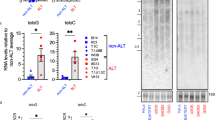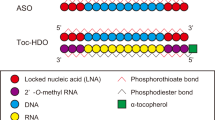Abstract
Aim:
To investigate the effect of the antisense oligonucleotides (ASODN) specific for human telomerase RNA (hTR) on radio sensitization and proliferation inhibition in human neurogliocytoma cells (U251).
Methods:
U251 cells were transfected with hTR ASODN or nonspecific oligonucleotides (NSODN). Before and after irradiation of 60Co-γ ray, telomerase activity was assayed by telomeric repeat amplification protocol (TRAP-PCR-ELISA), and DNA damage and repair were examined by the comet assay. The classical colony assay was used to plot the cell-survival curve, to detect the D0 value.
Results:
hTR antisense oligonucleotides could downregulate the telomerase activity, increase radiation induced DNA damage and reduce the subsequent repair. Furthermore, it could inhibit the proliferation and decrease the D0 value which demonstrates rising radiosensitivity. However, telomere length was unchanged over a short period of time.
Conclusion:
These findings suggest that an ASODN-based strategy may be used to develop telomerase inhibitors, which can efficiently sensitize radiotherapy.
Similar content being viewed by others
Log in or create a free account to read this content
Gain free access to this article, as well as selected content from this journal and more on nature.com
or
References
Natarajan S, Chen Z, Wancewicz EV, Monia BP, Corey DR . Telomerase reverse transcriptase (hTERT) mRNA and telomerase RNA (hTR) as targets for downregulation of telomerase activity. Oligonucleotides 2004; 14: 263–73.
Liu JP . Studies of the molecular mechanisms in the regulation of telomerase activity. FASEB J 1999; 13: 2091–104.
Rothkamm K, Löbrich M . Misrepair of radiation-induced DNA double-strand breaks and its relevance for tumorigenesis and cancer treatment. Int J Oncol 2002; 21: 433–40.
Purnapatre K, Varshney U . Cloning, over-expression and biochemical characterization of the single-stranded DNA binding protein from mycobacterium tuberculosis. Eur J Biochem 1999; 264: 591–8.
Pandita TK, Roti JL . Role of telomerase in radiocurability. Onc Rep 2003; 10: 263–70.
Wong KK, Chang S, Weiler SR, Ganesan S, Chaudhuri J, Zhu C, et al. Telomere dysfunction impairs DNA repair and enhances sensitivity to ionizing radiation. Nat Genet 2000; 26: 85–8.
Finnon P, Silver AR, Bouffler SD . Upregulation of telomerase activity by X-irradiation in mouse leukaemia cells is independent of Tert, Terc, Tnks and Myc transcription. Carcinogenesis 2000; 21: 573–8.
Norton JC, Piatyszek MA, Wright WE, Shay JW, Corey DR . Inhibition of human telomerase activity by peptide nucleic acids. Nat Biotechnol 1996; 14: 615–9.
Kondo Y, Koga S, Komata T, Kondo S . Treatment of prostate cancer in vitro and in vivo with 2-5A-anti-telomerase RNA component. Oncogene 2000; 19: 2205–11.
Chen Z, Koenemen KS, Corey DR . Consequences of telomerase inhibition and combination treatments for the proliferation of cancer cells. Cancer Res 2003; 63: 5917–25.
Corey DR . Telomerase inhibition, oligonucleotides, and clinical trials. Oncogene 2002; 21: 631–7.
Eckart M, Christine L, Marianne S, Yong W, Lora D, Eugen U, et al. Potent inhibitory activity of chimeric oligonucleotides targeting two different sites of human telomerase. Oligonucleotides 2005; 15: 255–68.
Nakamura M, Masutomi K, Kyo S, Hashimoto M, Maida Y, Kanaya T, et al. Efficient inhibition of human telomerase reverse transcriptase expression by RNA interference sensitizes cancer cells to ionizing radiation and chemotherapy. Hum Gene Ther 2005; 16: 859–68.
McCaul JA, Gordon KE, Clark LJ, Parkinson EK . Telomerase inhibition and the future management of head-and-neck cancer. Lancet Oncol 2002; 3: 280–8.
Goytisolo FA, Samper E, Martin-Caballero J, Finnon P, Herrera E, Flores JM, et al. Short telomeres result in organismal hyper-sensitivity to ionizing radiation in mammals. J Exp Med 2000; 192: 1625–36.
Kim MM, Rivera MA, Botchkina IL, Shalaby R, Thor AD, Blackburn EH . A low threshold level of expression of mutant-template telomerase RNA inhibits human tumor cell proliferation. Proc Natl Acad Sci USA 2001; 98: 7982–7.
Fu XH, Zhang JS, Zhang N, Zhang YD . Combination of telomerase antisense oligonucleotides simultaneously targeting hTR and hTERT produces synergism of inhibition of telomerase activity and growth in human colon cancer cell line. World J Gastroenterol 2005; 11: 785–90.
Masutomi K, Possemato R, Wong JM, Currier JL, Tothova Z, Manola JB, et al. The telomerase reverse transcriptase regulates chromatin state and DNA damage responses. Proc Natl Acad Sci USA 2005; 102: 8222–7.
Mo Y, Gan Y, Song S, Johnston J, Xiao X, Wientjes MG, et al. Simultaneous targeting of telomeres and telomerase as a cancer therapeutic approach. Cancer Res 2003; 63: 579–85.
Natarajan S, Chen Z, Wancewicz EV, Monia BP, Corey DR . Telomerase reverse transcriptase (hTERT) mRNA and telomerase RNA (hTR) as targets for downregulation of telomerase activity. Oligonucleotides 2004; 14: 263–73.
Kim SH, Kamainker P, Campisi J . Telomeres, aging and cancer: In search of a happy ending. Oncogene 2002; 21: 503–11.
Poole JC, Andrews LG, Tollefsbol TO . Activity, function, and gene regulation of the catalytic subunit of telomerase (hTERT). Gene 2001; 269: 1–12.
Bisoffi M, Chakerian AE, Fore ML, Bryant JE, Hernandez JP, Moyzis RK, et al. Inhibition of human telomerase by a retrovirus expressing telomeric antisense RNA. Eur J Cancer 1998; 34: 1242–9.
Zhang P, Xu Q, Chen WT, Duan LQ, Zhang ZY, Zhou XJ . Synergistic down-regulation of telomerase by all-trans retinoic acid and antisense oligonucleotide in oral squamous cell carcinoma cell line (Tca8113). Oral Oncol 2005; 41: 909–15.
Norton JC, Piatyszek MA, Wright WE, Shay JW, Corey DR . Inhibition of human telomerase activity by peptide nucleic acids. Nat Biotechnol 1996; 14: 615–9.
Chen Z, Koeneman KS, Corey DR . Consequences of telomerase inhibition and combination treatments for the proliferation of cancer cells. Cancer Res 2003; 63: 5917–25.
Author information
Authors and Affiliations
Corresponding author
Additional information
Project supported by grants from the National Natural Science Foundation of China (No 30171063).
Rights and permissions
About this article
Cite this article
Ji, Xm., Xie, Ch., Fang, Mh. et al. Efficient inhibition of human telomerase activity by antisense oligonucleotides sensitizes cancer cells to radiotherapy. Acta Pharmacol Sin 27, 1185–1191 (2006). https://doi.org/10.1111/j.1745-7254.2006.00417.x
Received:
Accepted:
Issue date:
DOI: https://doi.org/10.1111/j.1745-7254.2006.00417.x
Keywords
This article is cited by
-
Knockdown of telomeric repeat binding factor 2 enhances tumor radiosensitivity regardless of telomerase status
Journal of Cancer Research and Clinical Oncology (2015)
-
Telomerase as a useful target in cancer fighting—the breast cancer case
Tumor Biology (2013)
-
Association of telomerase activity with radio- and chemosensitivity of neuroblastomas
Radiation Oncology (2010)



